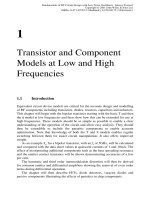Nguyên tắc cơ bản của thiết kế mạch RF với tiếng ồn thấp dao động P5
Bạn đang xem bản rút gọn của tài liệu. Xem và tải ngay bản đầy đủ của tài liệu tại đây (174.47 KB, 13 trang )
5
Mixers
5.1 Introduction
Mixers are used to translate a signal spectrum from one frequency to another. Most
modern RF/microwave transmitters, receivers and instruments require many of
these devices for this frequency translation. The typical symbol for a mixer is
shown in Figure 5.1.
Figure 5.1 Typical symbol for a mixer
An ideal mixer should multiply the RF and LO signals to produce the IF signal.
It should therefore translate the input spectrum from one frequency to another with
no distortion and no degradation in noise performance. Most of these requirements
can be met by the perfect multiplication of two signals as illustrated in equation
(5.1):
()( ) ()()()
tt
VV
tVtV
2121
21
2211
coscos
2
coscos
ωωωωωω
−++=
(5.1)
Here it can be seen that the output product of two input frequencies consists of the
sum and difference frequencies. The unwanted sideband is usually fairly easy to
remove by filtering. Note that no other frequency terms other than these two are
Fundamentals of RF Circuit Design with Low Noise Oscillators. Jeremy Everard
Copyright © 2001 John Wiley & Sons Ltd
ISBNs: 0-471-49793-2 (Hardback); 0-470-84175-3 (Electronic)
236 Fundamentals of RF Circuit Design
generated. In real mixers there are a number of compromises to be made and these
will be discussed later.
Mixing is often achieved by applying the two signals to a non linear device as
shown in Figure 5.2.
V
i
= V
1
+ V
2
Figure 5.2
Mixing using a non-linear device
The non linearity can be expressed as a Taylor series:
[][][]
.....)()()(
32
0
++++=
tVctVbtVaII
iiiout
(5.2)
Taking the squared term:
()( )
2
221
2
1
2
21
2
VVVVbVVb
++=+
(5.3)
It can immediately be seen that the square law term includes a product term and
therefore this can be used for mixing. This is illustrated in Figure 5.3 where the
square law term and the exponential term of the diode characteristics are shown.
Figure 5.3
Diode characteristic showing exponential and square law terms
Mixers 237
Note of course that there are other terms in the equation which will produce
unwanted frequency products, many of them being in band. Further, as the signal
voltages are increased the difference between the two curves increases showing
that there will be increasing power in these other unwanted terms.To achieve this
non-linear function a diode can be used as shown in Figure 5.4:
Figure 5.4
Diode operating as a non-linear device
If two small signals are applied then multiplication will occur with rather high
conversion loss. The load resistor could also include filtering. If the LO is large
enough to forward-bias the diode then it will act as a switch. This is a single ended
mixer which produces the wanted signal and both LO and RF breakthrough. It can
be extended to a single balanced switching action as shown in figure 5.5.
5.2 Single balanced mixer (SBM)
Figure 5.5
Switching single balanced mixer
The waveform and therefore operation of this switching mixer are now shown to
illustrate this slightly different form of operation which is the mode of operation
238 Fundamentals of RF Circuit Design
used in many single balanced transistor and diode mixers. The LO switching
waveform has a response as shown in Figure 5.6.
Figure 5.6
LO waveform for SBM
The spectrum of this is shown in equation (5.4) and consists of a DC term and
the odd harmonics whose amplitude decreases proportional to 1/n.
() ()
tn
n
n
tS
n
0
1
cos
2/
)2/sin(
2
1
ω
π
π
∑
∞
=
+=
(5.4)
If this LO signal switches the RF signal shown in figure 5.7 then the waveform
shown in Figure 5.8 is produced.
Figure 5.7
RF signal for DBM
Figure 5.8
Output waveform for SBM
Mixers 239
The spectrum of this can be seen to produce the multiplication of the LO
(including the odd harmonics, with the RF signal. This produces the sum and
difference frequencies required as well as the sum and difference frequencies with
each of the odd harmonics. The output voltage is therefore:
() () ()
()
()
+=
×=
∑
∞
=
)(cos
2/
2/sin
2
1
.cos
1
0
tn
n
n
tV
tStVtV
LO
n
RFRF
RF
ω
π
π
ω
(5.5)
It is important to note that there is no LO component. There is however an RF term
due to the product of
V
RF
with the DC component of the switching term. This
shows the properties of an SBM in that the LO term is rejected. It is often useful to
suppress both the LO and RF signal and therefore the DBM was developed.
5.3 Double Balanced Mixer (DBM)
If the switch is now fed with the RF signal for half the cycle and an inverted RF
signal for the other half then a double balanced mixer (DBM) is produced. This is
most easily illustrated in Figure 5.9.
Figure 5.9
Switching double balanced mixer
The output voltage is given by:
()
()
()
()
=
∑
∞
=
1
0
cos
2/
2/sin
cos2
n
LORFRF
tn
n
n
tVtV
ω
π
π
ω
(5.6)
The waveform is shown in Figure 5.10.









